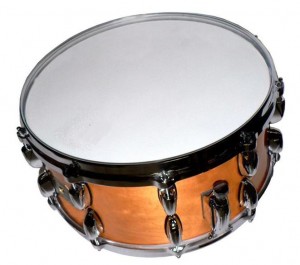
I walk into my office to a large stack of music on my desk, and my stomach turns over as I anticipate a collection of outlandish instrument requests by the composer. I can’t help but chuckle as I read down the list: propeller engine, guillotine sound, the bay of a Central American burro (alright, I made the last one up). Composers’ demands are getting stranger and stranger.
It comes with the job. Finding these instruments—or at the very least, a way to imitate the required sound—should be a challenge. These days, with all the wonderful technology available, it can be as simple as finding the correct sound effect or synthesized instrument on the Internet and playing it through a computer hooked up to an amp (this strategy proves useful when playing Harry Partch’s music). It’s a quick fix, but does it too often take some of the artistry out of what we do?
As percussionists, developing new sounds and techniques by experimenting with our instruments beyond the “norm” is an important part of our trade. Who came up with the idea to turn a suspended cymbal upside down, place it atop a timpani, and roll on it while manipulating the pedal? Genius! That was the product of experimentation. As technology continues to advance, we must fight the urge to succumb to the easy way out, and take the time to try out different ideas. Who knows? Through these valiant quests of trial and error may be an amazing discovery.
A good friend and colleague of mine named Andy was playing in the pit for Dialogues des Carmélites by Francis Poulenc. At the end of the opera there are multiple cues for the “fall and impact of a guillotine blade.” When I asked how he created the sound, he proudly replied, “All you need is an apple crate, a long piece of angle-iron, and a machete.” Brilliant! He claims the result was so jarring that the first oboe player was in tears. Indeed it could well have resulted from Poulenc’s dramatic writing, but when we tell the story, it’s because of Andy. Tip of the cap to you, sir! He never said where he got the idea. Regardless, someone took the time to experiment and make it happen. No computer-simulated sound could stack up to the sheer realism of the apple crate and machete.
At the same institution, our percussion ensemble performed Ballet Mécanique by George Antheil, whose score calls for a propeller airplane engine. Luckily, my professor was very close with some of the “higher-ups” in the aircraft industry around town. I’d be lying if I said he didn’t do everything in his power to obtain them. Quite a bold move, I must say. To my dismay, questions about the safety of the players and audience arose, and the idea was quickly dismissed. Yet another idea we entertained was to push leather straps into the blades of large fans. Unfortunately, no fans with enough torque to meet our needs were available. After many possible alternatives were discussed, we made the decision to use computers to generate the desired effect.
It is this type of innovation and imagination that makes our jobs entertaining and interesting. Granted, in some cases there may be no other choice than to go the technology route, but where do we draw the line? I encourage all percussionists to further explore the sounds of the instruments we use everyday. There are so many sounds yet to discover.
Daniel Cathey is a D.M.A. Candidate in Percussion Performance at the
University of Georgia
"News related to the modern world of classical music."






R. Oettle,
I did record airplane sounds. I live under the landing pattern for ICT airport and I spent multiple hours recording planes on final approach, as well as going to a small airport and recording the engines of Cessna 150’s and 172’s. I wish I could have gotten a clean take on a King Air, but the sound bites I had I used with the help of pro-tools to make a loop. Then I wired up a switch box that operated two large warehouse fans. When the part for the airplane came up, I simply ran the sound clip and engaged the fans to create a real feel to it. It through the audience off, they actually thought the big fans were making the noise because I had my PA speakers hidden.
yes. there is something about “hands on” that produces a different more direct final image sound whatever.
people making marks.
Great article. This applies to all forms of creatuve realms like design too. Computers are easy to use but they take a lot of experimentation out of the process. We lose so many good ideas because of it. It’s important to get back to your roots. I mean the innovation of instruments starts with the experimentation you talk about. Without trying something new no new instruments will be born.
Unfortunately, we spent so much of our time thinking big, that we missed an easier solution. By then, it was just too late.
Dan,
You’ve got me wondering why, for the Ballet Mécanique by George Antheil, you didn’t consider recording the sound of running engines and play that back. Why would that be any less authentic than synthesizing the sound?
That option was discussed, but our concert was very close and there wasn’t enough time to make it happen.